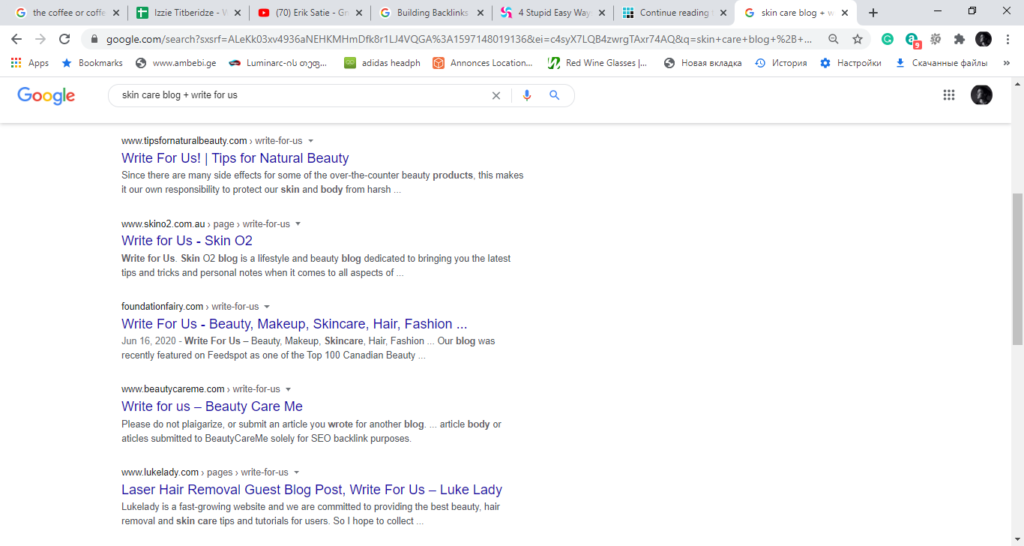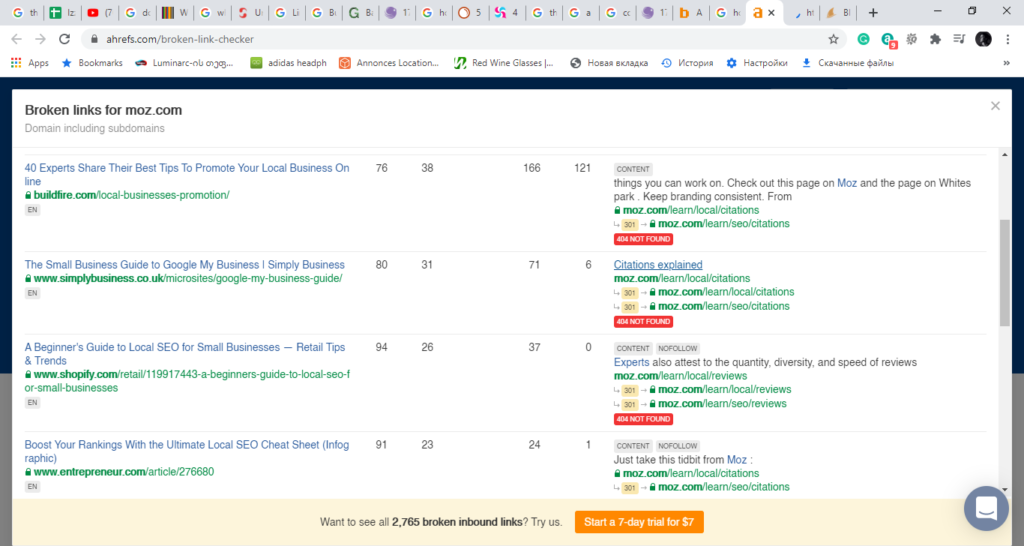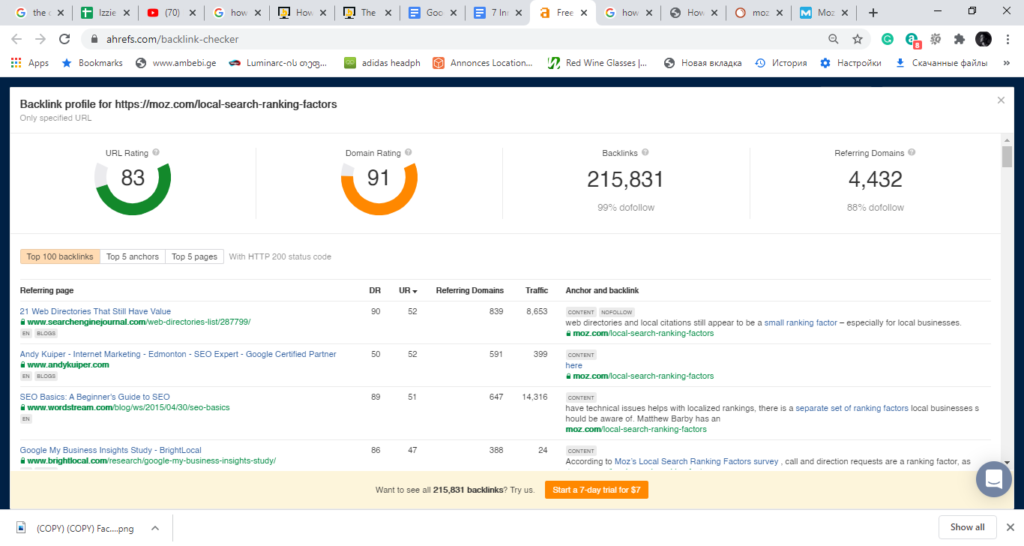Building Backlinks for eCommerce
With 2.05 billion online shoppers, eCommerce has become the largest sector of the technology industry. One out of four people is an online shopper because buying products online is convenient, faster, and more comfortable. Now you may think, if so many people are shopping virtually, then your eCommerce website will have no problem getting lots of visitors and selling products. People want to buy things online, and you sell things online, so what can go wrong? However, the number of online sellers keeps rising, too. In 2020, there are between 12 million to 24 million eCommerce sites in the world. Every day, approximately 547,200 new websites appear on the internet, and with so many new online stores, you need to beat the competition and keep making sales.
The most effective way to increase your number of customers is to improve your website’s online visibility in search engines. When your potential clients type a keyword such as “buy a sulfur mask online” into a search engine, even if the mask you sell can work wonders to their skin, and it’s what the searchers want to buy, your eCommerce site may not appear at the top of the results in their search queries. Numerous factors determine your positions in search results, and to improve your online rankings, you need to invest in Search Engine Optimization (SEO). While SEO for eCommerce is more than just link-building, other websites linking to yours indicate your pages are relevant and your site is authoritative. Backlinks are almost like online votes, and when many sites link to yours, Google trusts you more.
Not All the Backlinks Work the Same Way for Your SEO
Before heading to the ways of building more backlinks to your site, we should identify the types of links you may earn from others. Getting links from other sites is crucial in SEO, but not all backlinks can improve your online rankings in the same way. To combat blog comment spam and prevent spam sites from appearing at the top of Google search results, Google created a nofollow tag in 2005. A nofollow link has nofollow value in its rel – the attribute specifying the relationship between the current page and the linked page. It tells search engines to ignore the link so that it doesn’t have an impact on online rankings. A dofollow is technically any link that doesn’t have this attribute and can directly boost your online visibility.
“Use this attribute for cases where you want to link to a page but don’t want to imply any type of endorsement, including passing along ranking credit to another page.” – Google
At the beginning of the “nofollow era,” the search engine would not consider links with this tag as a ranking factor. As of today, the nofollow attribute still tells Google the website linking to yours doesn’t want to give you a vote, but Google started considering it as a hint to decide which pages to include in a search.
Additionally, Google introduced two new link attributes in 2019:
rel=”sponsored” – webmasters can use the attribute to identify links that are part of advertisements, sponsorships, or other compensation agreements.
el=”ugc”: UGC stands for User Generated Content, and Google suggests using the ugc attribute value links within user-generated content, such as comments and forum posts.
“All the link attributes, sponsored, ugc, and nofollow, now work today as hints for us to incorporate for ranking purposes. For crawling and indexing purposes, nofollow will become a hint as of March 1, 2020.” – Google
Even if other sites tell Google not to crawl your site, the website visitors may click the link and land on your site, which means your traffic keeps increasing. Additionally, one nofollow link from an authoritative website may create several dofollow links, because the more website owners see your content, the more chances you get to earn more backlinks.
Generally, you should aim to get as many backlinks as possible without violating Google’s Webmaster Guidelines and participating in any link schemes. In this article, we will focus on earning more high-quality backlinks that will directly impact your SEO and improve your online visibility and the steps that will help you get votes from other websites.
How to Build More Backlinks to Your Ecommerce Website
Create a Content Marketing Strategy
You may say you are a seller, not a writer, and I have to create content? Really? But nothing is more powerful in bringing more backlinks than an informative piece of content. The thing is, content in the SEO world is like the queen in chess – the most powerful piece among others. People love reading articles, guides, or information about different products before making any purchase. Content allows website owners to include more keywords on the site, appear in more search queries, and increase the number of website visitors. Many sellers are incorporating content in their digital marketing strategies, and with so many writers out there, high-quality content may have become the primary source of getting backlinks from other sites. By having a blog, you increase the possibility of getting more links from other sites while educating your website visitors and possibly converting some to your customers. The content you create can be blog posts related to the products you sell, product comparisons, guides, or case studies. Not only text, but visuals in your blog posts – such as Infographics, graphs, and diagrams, or compelling pictures and videos – can all be a reason for other sites to point to yours.
Guest Blogging
Guest blogging means writing a compelling blog post for another site from the same industry where you include a link to your website. For instance, if you sell sulfur masks, you could write about ways to reduce excess sebum. Among other tips, you could share the information on sulfur’s effect on the skin and perhaps include a before and after picture of someone using your product. If done right, guest blogging can help your SEO and improve your online rankings. However, many site owners misused the power of guest blogging to the point where Matt Cutts, the former head of Google’s webspam team, had to dedicate an entire article to the downside of guest blogging and encourage website owners to stop using this technique.
The article The decay and fall of guest blogging for SEO became quite arguable among SEO experts and website owners, and many didn’t quite grasp the idea behind Cutt’s reasoning.
“I’m not trying to throw the baby out with the bathwater. There are still many good reasons to do some guest blogging (exposure, branding, increased reach, community, etc.). Those reasons existed way before Google, and they’ll continue into the future.”
So, perhaps what Cutts meant is that any spammy guest blogging that involves getting links in exchange for money, or involving low-quality articles, non-authoritative sites, or techniques to trick the Google algorithm, may harm your rankings. The goal of the guest-blogging should be creating high-quality content that informs the audience and may increase the exposure to your site. Guest blogging, when done right without the intention to manipulate rankings, is a perfect way of getting high-quality backlinks. Having guest writers is also beneficial to bloggers who will end up with fresh content on their site, which itself is crucial for maintaining top positions on Google. To find blog posting opportunities, you need to find blogs that allow guest writers. If you sell skincare products, for instance, type in “Skincare blog + write for us” on Google, and you will see pages that will be happy to cooperate with you.

Find Broken Links
Hundreds or even thousands of sites link to pages that don’t exist anymore. Nobody wants broken links to their website because it results in poor user experience and users’ frustration when they click on the link to look at “Oops! The page doesn’t exist.” If you find a broken link on a website and offer a piece of content to link to instead of the broken link, you get a chance of increasing the number of backlinks to your site – so why don’t you give it a shot? The great tool to use to find broken links is Ahrefs’ broken link checker.

Here you can type in one of your competitors’ domains and see how many sites link to their broken pages. In the list of other sites pointing to the broken pages, you can see some backlink opportunities based on the topic of the broken page and also the traffic on the site that links to the page. Choose the page you’d possibly want to recreate and type the broken link in site explorer. You will see how many sites link to the page. There may be 20 websites pointing to a page that doesn’t exist. That means you get a chance to receive 20 backlinks. Similarly, if there is a website you’d want to link to yours because of its authority and reputation, you can type in the site’s domain in Ahrefs’ broken link checker and see the broken outbound links.
Skyscraper Content
A fantastic link-building technique for eCommerce websites is Skyscraper Content. With this technique, you search for the topics related to your products and see what pages have top positions in a query. For instance, if you search for “how to take care of oily skin,” you’ll see blog articles are at the top of the search results. You choose the article with top positions and add everything you think is missing from the content. The idea behind the Skyscraper Technique’s idea is to create much better, informative, and perhaps a longer piece of content related to the topic. On the final step, you reach out to the websites linking to the content you chose and let them know you have something better to offer. There is no guarantee anyone will replace the link with the one to your blog post, but it’s worth giving it a shot.
To see which sites link to the article you chose for implementing the Skyscraper Content technique, you can use tools such as free Backlink Checker by Ahrefs.

Get Social
Social signals aren’t direct ranking factors, and if social links counted as backlinks, it would be too simple to manipulate online rankings. However, many eCommerce websites miss out on the power social media can have on acquiring more backlinks. Social media accounts increase exposure to your brand and give you more chances to share your content online. The increased exposure to your content means more website owners look at your blog posts, pictures, graphics, and videos, and it grows the possibility of getting more links from other sites. Getting links from other websites is an essential step you need to take to increase positions on Google and get more traffic to your eCommerce website. We hope with the techniques above, you can keep increasing the number of backlinks to your site so more potential customers visit your online store and start buying from you.


